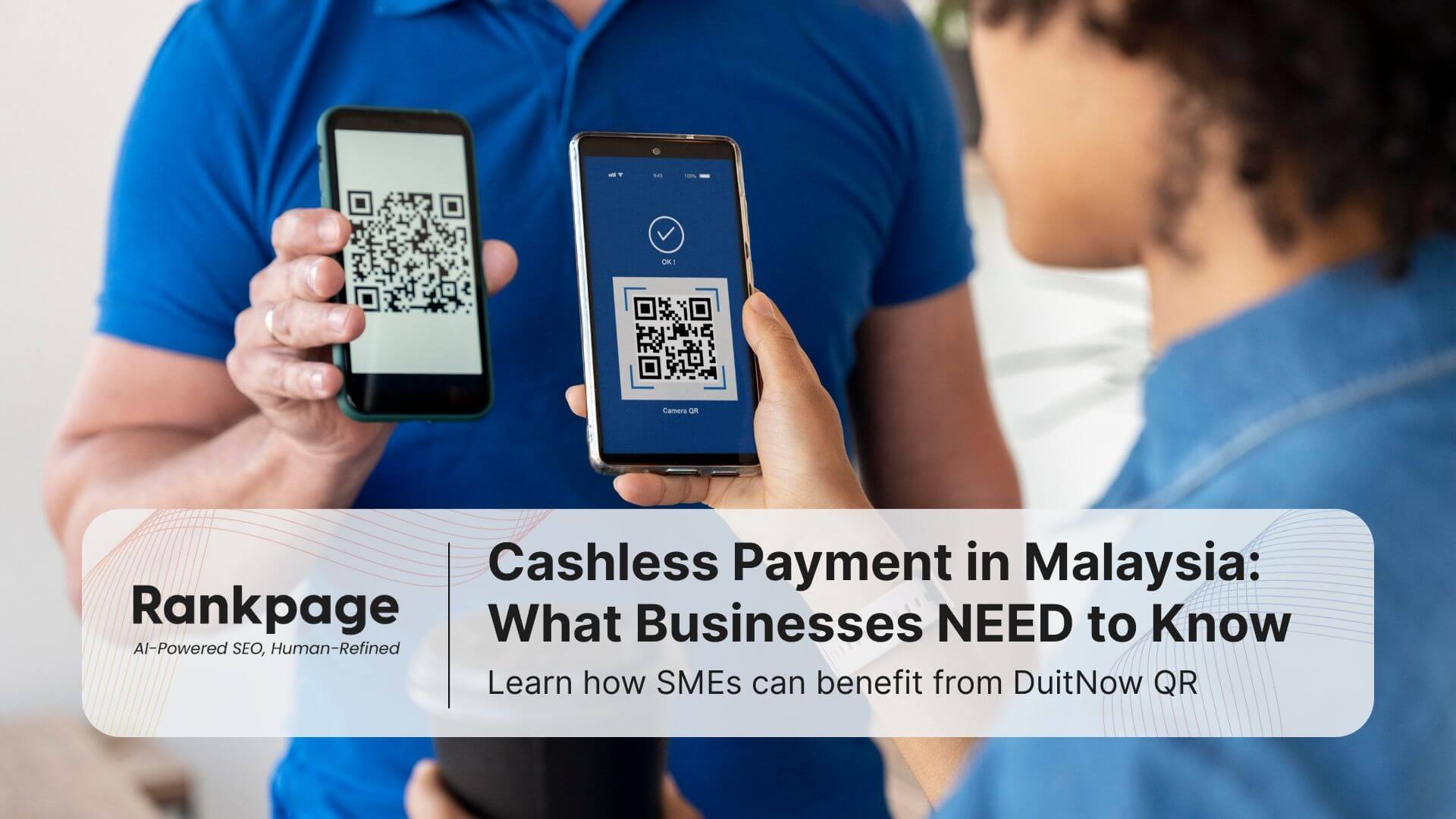Key Takeaways
- Cashless payment adoption surged in Malaysia, with 870 million DuitNow QR transactions in 2024, more than double 2023’s figure, valued at RM31.1 billion.
- SMEs that accept cashless options attract a wider base, especially Gen Z and urban consumers, many of whom rarely carry cash.
- Bank Negara Malaysia (BNM) regulates all payment providers, ensuring security, interoperability, and capped merchant discount rates for fairness.
- DuitNow QR is the national standard — one QR code now works with over 40 banks and e-wallets, reducing setup complexity for merchants.
- Businesses benefit beyond payments: instant digital records for SST filing, CRM and loyalty integrations.
Cashless payment in Malaysia refers to digital transactions using QR codes, e-wallets, contactless cards, or bank transfers, without handling any physical cash.
If your cashier is still waiting for customers to count out 20 sen coins, it’s probably time for an upgrade. In 2025, cashless isn’t just a convenience that makes your POS systems go smoothly, it’s a customer expectation, especially in urban retail and food outlets where many retailers are already offering cashless payments.
Today, we will break down how cashless payment works in Malaysia, why adoption is accelerating and how local businesses can get started with the right tools and providers.
Table of Contents
What Is Cashless Payment, Exactly?
Cashless payment refers to any transaction made without physical cash, think QR scans, card taps, or online bank transfers. In Malaysia, this commonly include:
- E-wallets like Touch ‘n Go, GrabPay, ShopeePay
- Debit/credit card payments via contactless terminals
- Bank transfers through FPX or DuitNow
- QR code payments (standardised via DuitNow QR)
It’s fast, convenient, and leaves behind a digital trail, which is great for business tracking and tax reporting.
Why Are Malaysians Going Cashless?
Because Malaysians really hate digging for loose change. But jokes aside, the government and consumers are aligned:
- BNM’s Financial Sector Blueprint pushes for a cashless, efficient digital economy
- COVID-19 accelerated adoption of touch-free payments
- E-wallet incentives (RM30 eTunai Rakyat, eBelia provided RM150)
- Retail tech upgrades made it easier for small businesses to accept QR payments
“BNM reports about 870 million DuitNow QR transactions in 2024 (up from 360 million in 2023), with RM31.1 billion in value.”
What Types of Cashless Payment Should a Retail Business Offer?
Offer what your customers already have in their pockets. Here’s what’s worth considering:
Malaysia E-wallet comparison:
| Payment Type | Best For | Popular Brands | Key Features | Fees (Estimated) |
| QR Payment | Micro to large merchants | DuitNow QR (TnG, GrabPay, etc.) | Unified QR, instant settlement | 0%–1% per transaction |
| E-Wallets | Younger, mobile-savvy shoppers | Boost, ShopeePay, BigPay | Loyalty tie-ins, cashback promos | 1%–2% per transaction |
| FPX/Bank Transfers | Online or higher-ticket items | Maybank2U, CIMB Clicks | Real-time bank transfer | ~RM0.50/txn (bank-dependent) |
| Card Terminals | Traditional retail setups | Visa, Mastercard | Contactless tap, physical card | 1.5%–2.5% (merchant fee) |
Most retail businesses now mix and match based on customer preference and POS system capabilities.
Is It Safe for Businesses to Accept Cashless Payments?
In Malaysia, cashless payment systems are tightly regulated by Bank Negara Malaysia (BNM) to ensure security, reliability, and fair practices.
So, while cyber threats exist, the system is designed to protect both you and your customers, if you choose the right platforms.
Use Only BNM-Licensed Providers
Before signing up, check that your POS terminal or e-wallet provider is approved by BNM. Licensed issuers follow strict operational and capital requirements to safeguard your funds and data.
- You can verify providers on BNM’s official list of approved payment service providers.
- Popular names like TNG Digital, Boost, GrabPay, and Paydibs are fully licensed.
DuitNow QR Is Backed by PayNet Security
All merchants using DuitNow QR must adhere to PayNet’s centralised security framework, which includes real-time monitoring, fraud detection, and settlement protections.
- QR codes are dynamic or static but always encrypted.
- Merchant settlement timing depends on the acquirer, commonly T+1 (next business day) for terminals
- Transactions Are Encrypted & Traceable
Every tap, scan, or transfer is processed over secure, encrypted networks. Unlike cash, digital payments leave a verifiable trail, which helps with dispute resolution and bookkeeping.
Businesses should only display the official DuitNow QR code provided by your vendor. Avoid unknown apps or shared codes downloaded from suspicious sources, especially those that don’t use two-factor authentication or proper SSL encryption.
What Are the Business Benefits of Going Cashless?
Besides not having to deal with “Bang, I only got RM100, ada small change ah?”, going cashless brings real business wins.
This isn’t just a convenience upgrade. Adopting digital payments means better operations, better marketing, and (let’s be honest) fewer headaches at the till.
Faster Checkout, Shorter Queues
Whether you run a café, food truck, or clothing boutique, time is money especially during lunch hour or weekends. With QR or tap-to-pay, customers get out faster, and you serve more people.
- One scan, one beep, one satisfied customer
- No fumbling with notes or coins, no waiting for change
Attract More Customers Who Don’t Carry Cash
Many shoppers (especially Gen Z and working adults) don’t even carry cash in their wallet, just their phones. By accepting cashless methods like DuitNow QR, TNG, GrabPay, and cards, you make it easier for them to choose your store over others.
More payment methods = More potential customers. It’s that simple.
Better Bookkeeping and Tax Filing
Digital payments leave a clean paper trail. That means:
- Easier SST reporting (no more chasing faded receipts)
- Automated daily sales reports
- Simple cashflow tracking via your dashboard or bank portal
Unlock Loyalty, CRM & Upsell Opportunities
Many cashless systems integrate with apps or platforms that help you:
- Offer digital stamp cards or loyalty points
- Send promo messages to returning customers
- Link to inventory or CRM tools
This helps you retain more customers without lifting a finger.
Lower Theft Risk & Shrinkage
No physical cash = no drawer to rob.
Less risk from internal errors or losses and safer late-night closings, especially for F&B or retail operators
Sales Boosts Are Real
Retailers who adopt QR payments often see a 10–25% increase in average basket size, because customers aren’t limited by what’s in their pocket.
They can directly access their bank account to top-up their balance and even use BNPL if your business offers them.
How Can Businesses Start Accepting Cashless Payments?
If your shop has Wi-Fi and a phone, you’re halfway there. The rest is just setup.
Getting started with cashless payments isn’t complicated, but doing it right the first time can save you time, confusion, and “Eh boss, cannot scan!” moments.
Step 1: Choose a Trusted Payment Provider
Start with what you already have, does your POS system support cashless plugins? If not, explore local options like:
- Touch ‘n Go eWallet
- Paydibs
- GrabPay Biz
- Billplz
- Stripe (for online stores)
Look for BNM-licensed providers with good merchant support.
Step 2: Register for a Merchant Account
You’ll need basic business info to apply:
- IC of the owner
- SSM registration cert
- Business name, contact, and bank account details
Most providers have simple online forms, and approval can take 1–3 working days.
Step 3: Install the Terminal or QR Display
For retail: Get a DuitNow QR printed or a terminal delivered to your shop.
For online: Integrate the API or checkout plugin on your website.
Most QR setups now work with multiple wallets. So one QR code covers TNG, GrabPay, Boost, Maybank. Saves you the hassle and long waiting times.
Step 4: Test Before You Go Live
Always test with a real payment after you got everything set up, even RM1. You don’t want your first QR transaction to fail during the weekend lunch crowd.
- Double-check that receipts and bank settlements are syncing correctly
- Check if your POS shows the transaction in real time
Step 5: Train Your Staff (Yes, Even Part-Timers)
Make sure everyone knows:
- How to scan customer QR codes
- How to explain the process to confused customers (especially first-timers)
- What to do if the Wi-Fi goes down or the terminal hangs
Some providers offer free onboarding videos in Bahasa Melayu or Mandarin, great for team training.
What About Fees and Hidden Costs?
Watch the fine print, but the cost is often less than you think.
- QR Payment via DuitNow: Free or low-cost, capped at ~1% (often waived for small merchants)
- E-wallets: Some charge monthly maintenance or higher fees for premium analytics
- Card terminals: Higher setup and per-transaction charges — but sometimes bundled with POS systems
- FPX: Transaction fee is usually flat (RM0.50)
Compare 3–4 providers based on your transaction volume. Some offer fee waivers if you hit monthly targets.
Conclusion on Cashless Payment in Malaysia, the Next Big Thing
Cashless payments aren’t just a feature anymore, they’re part of how Malaysians expect to shop, dine, and pay.
Whether you’re running a boutique in Penang, a kopitiam in KL, or an online store nationwide, choosing the right cashless setup matters, for your customers and your bottom line.
At Rankpage, we work with retail and SME businesses to optimise not just your payment systems, but your visibility online.
We build SEO-optimised pages that drive foot traffic and digital leads and make sure customers can find you wherever, whenever with our local SEO services.
Need help building a digital sales funnel that converts? Let’s map out your next move and get those sales and conversions up, up, up.
Frequently Asked Questions About Cashless Payment in Malaysia
What Is The Most Common Cashless Payment Method In Malaysia?
DuitNow QR is the most widely used due to its interoperability with major e-wallets and banks.
Can Small Businesses In Malaysia Afford To Go Cashless?
Yes. Many solutions offer free setup and low transaction fees, especially for QR-based payments.
Are Cashless Payments Secure?
Yes, when processed via BNM-licensed providers and verified platforms.
Do I Need Multiple Qr Codes For Each Wallet?
No. DuitNow QR consolidates all major wallets under one code.
Can I Use One Provider For Both Online And In-Store Payments?
Yes. Many Payment Gateways Offer Omnichannel Support With A Single Dashboard.
Is Cashless Payment Mandatory In Malaysia?
No, but many customers now expect it, especially in city and retail-heavy areas. Business will lose out immensely compared to their competitors who do offer cashless payments.





